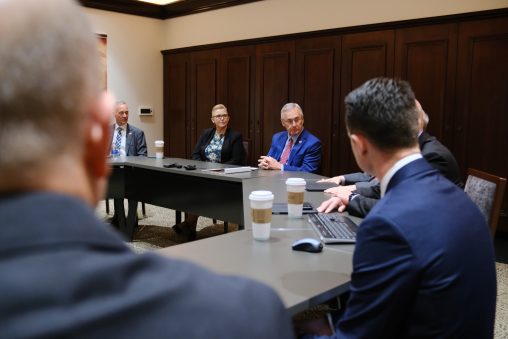 As Ohio looks to inventory the current status of its higher education facilities and determine regional needs, the economic comeback in the Dayton area has not gone unnoticed by state officials.
As Ohio looks to inventory the current status of its higher education facilities and determine regional needs, the economic comeback in the Dayton area has not gone unnoticed by state officials.
Lt. Gov. Jim Tressel visited Wright State University for a workforce development roundtable and facilities tour on April 10, where he spoke with local business, education and community leaders about what local workforce issues need addressing.
This is part of Tressel’s assignment from Gov. Mike DeWine to establish the Ohio’s Workforce Playbook – a regionally focused plan to retain and recruit talent to Ohio and rally the state’s existing workforce to greater productivity.
“We’ve got to be maybe less redundant at times. We’ve got to be extremely efficient and effective with limited resources, and that’s hard,” Tressel said. “As an entire state, we’ve got to figure out how we can be efficient and effective so we can meet those opportunities.”
By meeting with higher education institutions and holding discussions, he can identify regional areas of need. Wright State marked the second university visit in the state, with Cleveland State University being the first.
“The pendulum has swung back, and now it’s our job being educators – I still consider myself an educator – to make sure that we can collectively get together and assess exactly [what these opportunities are],” Tressel said. “We keep saying we’ve got lots of opportunities, but what are they, and what do we need to create?”
Building on the discussions about workforce needs and opportunities, it’s important to note the region’s positive momentum over the last few years in many economic aspects and what Dayton needs from the state to continue growth.
Here are the key takeaways from the roundtable:
Main points:
- Partnerships between medical groups and higher education institutions allows for both more comprehensive medical coverage within lacking areas and learning opportunities for students.
- Offering educational programming that supports local workforce needs helps retain students after they graduate.
- Dayton has room to improve in terms of children’s health metrics, both in mental and physical health. Ensuring the younger generations are healthy and introducing them to future pathways helps development.
- Healthcare partnerships and addressing accessible care shortage
- Access to local medical and pediatric care for rural neighborhoods to the north of Dayton is a key weakness that both local and state leadership is looking to address.
Through partnerships between medical practices and colleges, such as those Wright State has between Dayton Children’s and Premier Health, health care education is supported by expanding nursing, medical student and residency programs.
Dr. Chad Whelan, COO and the president of Miami Valley Hospital, acknowledged these efforts are partially supported by the Directed Payment Program (DPP) that enables the Ohio Department of Medicaid to direct payments to providers based on certain criteria, such as meeting specific quality goals or addressing payment disparities.
Deborah Feldman, president and CEO of Dayton Children’s, said the $25 million investment the hospital received in the last budget was critical to the ability to expand its behavioral health services, staffing and facilities.
The needed continuance of support through the state was emphasized, as health care partnerships within the region continue to look to expand rurally and address critically needed areas without coverage.
“We know we need access to primary care in most of the communities around us, and we want to build that out,” Whelan said. “We also know a lot of people who live in our community …have to get in the car right now and drive outside of their community to get care. We want to collectively build those programs right here and get care locally.”
Teaching students what’s needed locally
A primary goal for local institutions, like Wright State, is retaining graduates in the local workforce, particularly for the defense industry at Wright-Patterson Air Force Base –the region’s largest employer– and the surrounding companies supporting it.
By specifically tailoring programming to Wright-Patt AFB’s workforce needs, students attending these institutions are already near internship and job opportunities.
Wright State’s new Center for Civics, Culture and Workforce Development and Digital Innovation and Integration Center of Excellence, led by Jason Anderson, is focused on the history of ideas, traditions and literature that have influenced the development of American society, constitutionalism and the armed forces. It also directly addresses the workforce needs of Wright-Patt AFB and industries that support the base.
The center has already identified a few four year programs that should be considered for addition. That programming would be funded by the $6 million currently allocated to the school in the governor’s budget.
Future Generations’ Health and Education
Ensuring the upcoming generations of people are both mentally and physically healthy helps prepare them for the workforce. This is still a work in progress in the region.
“We don’t raise healthy children,” Feldman said. “Children in Ohio are not as healthy as they need to be, and in this region, unfortunately, we also fall below the state averages in most [metrics] of children’s health.”
One aspect of the state’s efforts aiming to encourage children to adopt healthy physical habits and in turn improving their mental health, according to Tressel, is the upcoming implementation of a governor’s fitness challenge in schools.
In terms of making sure students understand what career options are just outside their doors, Wright State President Sue Edwards discussed the importance of the Hoopla STEM Challenge on introducing local K-8 students to relevant skills for local workforce shortages.
“They can actually see the pathway from where they’re at in elementary and middle school through to college degrees,” Edwards said.
All of these points demonstrate the multifaceted approach necessary for sustaining Dayton’s economic growth. Continued focus on these areas will be vital for the region’s success. Tressel reiterated his thoughts on the state of Dayton at the end of the roundtable:
“The pendulum has swung back.”

 Bags, boards and bonding
Bags, boards and bonding  More than 1,000 students to graduate at Wright State’s fall commencement ceremonies
More than 1,000 students to graduate at Wright State’s fall commencement ceremonies  Wright State’s Take Flight Program helps students soar high
Wright State’s Take Flight Program helps students soar high  Wright State Police Department delivers major donation to Raider Food Pantry
Wright State Police Department delivers major donation to Raider Food Pantry  Wright State engineering and computer science students earn prestigious federal SMART Scholarships
Wright State engineering and computer science students earn prestigious federal SMART Scholarships 